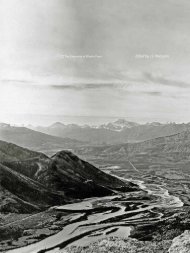C Ihe Ladies c cu. V'VVAN - History and Classics, Department of
C Ihe Ladies c cu. V'VVAN - History and Classics, Department of
C Ihe Ladies c cu. V'VVAN - History and Classics, Department of
- No tags were found...
You also want an ePaper? Increase the reach of your titles
YUMPU automatically turns print PDFs into web optimized ePapers that Google loves.
198 Appendix 1doctor." Vyvyan attempted to st<strong>and</strong>ardize <strong>and</strong> correct placenames in writing her book, <strong>and</strong> left out some <strong>of</strong> the storiesrecorded in the field notes. Descriptions <strong>of</strong> communities are<strong>of</strong>ten condensed, perhaps because, after so long, Vyvyan wasmore interested in character <strong>and</strong> wilderness than in the settlements,or was unable to distinguish among them any longer.The published narrative also had to balance local colour withthe geographical movement <strong>of</strong> the narrative in order to avoidhaving the travel overburdened by anecdote <strong>and</strong> incident.When she wrote her book, Vyvyan seems to have had littleinterest in updating her material historically. More importantto her than the facts <strong>and</strong> details recorded in the field noteswere the impressions evoked by the wilderness; accordingly, thebook is structured in terms <strong>of</strong> geography <strong>and</strong> event rather thanin terms <strong>of</strong> daily entry. This restructuring means that materialappears differently in the narrative. Of a fairly incidentalsignificance is the attribution <strong>of</strong> information to differentcharacters in the narrative than in the field notes, such as whenVyvyan attributes the description <strong>of</strong> Hudson Stuck to Dr Burke(above, 171), whereas it was Harry Anthony who told her thatStuck was "a man who did all his own thinking. You could h<strong>and</strong>him nothing" (25]uly). Diction becomes more formal in thetransition to publication; the six "scally-wags" on the jury inAklavik (24]une) become "a collection <strong>of</strong> the toughest ruffiansimaginable" (60), <strong>and</strong> the "comic opera" <strong>of</strong> steamer l<strong>and</strong>ingsin the field notes becomes "some scene in a ballet" (48).Details <strong>of</strong> travel are also moved, simplified, or combined totighten the story; thus, on the trip across Great Slave Lake, theSS Distributor ties up at both Mission Isl<strong>and</strong> (I4-15]uly) <strong>and</strong>Green Isl<strong>and</strong> (I6July) in the field notes, but only oneunnamed isl<strong>and</strong> is described in the book, <strong>and</strong> it draws onelements from both field note entries. Similarly, the caribousighted the morning <strong>of</strong> 19]uly <strong>and</strong> the wolf tracks recorded on2I]uly are conflated in the book into one night's observations(148-49). In another example, the "King William l<strong>and</strong> Eskimolong haired man <strong>of</strong> the woods" who performs the seal dancewith Ikagena in Aklavik after the murder trial (24june) disappearsfrom the book, <strong>and</strong> Ikagena himself, who, "with his longhair <strong>and</strong> strange face, seemed to us like a wild man <strong>of</strong> thewoods" (58), performs the dance alone.Of more significance, <strong>and</strong> perhaps in the service <strong>of</strong>propriety when entering the public arena, Vyvyan's indictments<strong>of</strong> the HBC's exploitation <strong>of</strong> its northern <strong>cu</strong>stomers (27june) do not appear in the published narrative, <strong>and</strong> her negativedescriptions <strong>of</strong> the northern churches <strong>and</strong> their appeal tothe indigenous peoples are tempered. As well, many <strong>of</strong> thestrong female figures met by Vyvyan <strong>and</strong> Dorrien Smith playno part in the published narrative, which portrays the northmore conventionally as a place for male adventure in thewilderness. Miss Ross, the nurse at Fort McMurray (3]une),<strong>and</strong> Mrs Burgl<strong>and</strong>, who is raising a family in a one-roomAlaskan cabin (28July), seem to have inspired the women withadmiration, but cannot be found in the book. Mrs LauraF razeur survives in the book as a previous traveller, but is notconnected with the anonymous woman who was ab<strong>and</strong>oned byher guides <strong>and</strong> who so haunts Vyvyan's relations with Sittichinli<strong>and</strong> Koe.Creating a story, where tension <strong>and</strong> doubt are overcome bythe women's steadfast resolve, thus produces changes in thematerial. The playful question, on 9july, "Has the Rat a spiteagainst us?" is heightened in the narrative to musings about the"malignant" Rat (39, 108). The field notes underplay thewomen's doubts as they prepare for the journey; the narrativeuses their doubts for aesthetic purposes, to engage the readerin their undertaking. In the field note entry recording SgtAnderton's encouragement for their endeavour, Vyvyan celebrateshis knowledge <strong>and</strong> judgement as being "So differentfrom Winnipeg + SS. Distributor croakers," <strong>and</strong> notes that, inthe context <strong>of</strong> other northern exploits, their own adventureappears" smaller," less risky (27 June); with the adventure stillahead <strong>of</strong> them, Vyvyan considers it a reasonable, manageableundertaking for two inexperienced travellers. In the book,where their adventure is the centre <strong>of</strong> the story, Vyvyan'sperspective emphasizes how significant it actually was in relationto their inexperience, which she suggests Andertonunderrated (74-5). It is not that one version or the other ismore "true," but that, having accomplished the journey,looking back from a lifetime <strong>of</strong> travel, Vyvyan sees the experiencedifferently from that earlier self, who was preparing,psychologically <strong>and</strong> physically, to face the Rat River.Editorial notes concerning the field notes will be foundcollated with the notes to the chapters <strong>of</strong> the book; they comeafter the last note to each chapter <strong>and</strong> are arranged so that theyappear under whichever chapter covers the events <strong>of</strong> theirrespective dates.In this presentation <strong>of</strong> the field notes, the form <strong>of</strong> the datedheadings has been st<strong>and</strong>ardized, but spelling <strong>and</strong> punctuationremain as they are in the original. Where they vary substantively
















